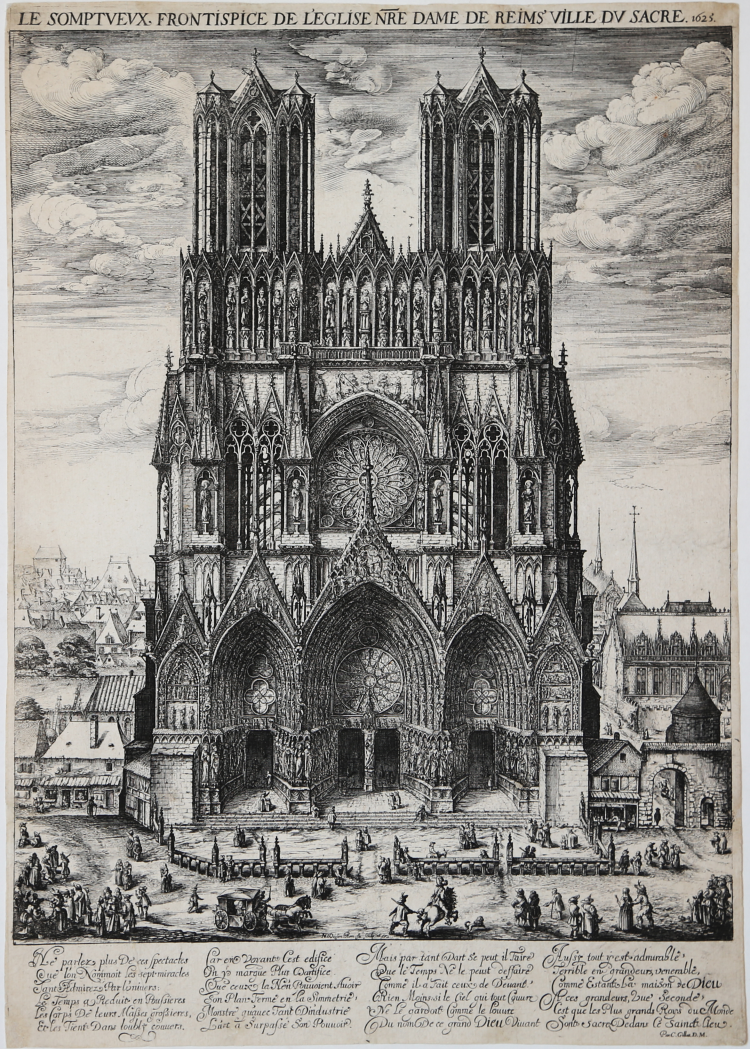



| Reference: | S42061 |
| Author | Nicolas De Son |
| Year: | 1625 |
| Measures: | 319 x 443 mm |


| Reference: | S42061 |
| Author | Nicolas De Son |
| Year: | 1625 |
| Measures: | 319 x 443 mm |
Etching, 1625, signed at the bottom center N. Deson Rem. In. Sculp. Et ex.
Magnificent proof, rich in tones, of the second state of three with the artist's imprint, printed on contemporary laid paper, trimmed to the copperplate, printing crease in the lower left corner, minimal abrasions on the verso, otherwise in excellent condition.
Rare etching of the façade of Reims Cathedral by the local artist Nicolas de Son (active 1625-37), who was part of a brief flourishing of native printmaking in the province of Champagne from the 1620s through the 1640s along with such artists as Edmé Moreau, Jean Colin, and Nicolas Regnesson. The large print represents the cathedral’s west front in great detail, with not only the broader compositions of the major sculptural programs clearly delineated, but also several ancillary architectural and sculptural passages, such as the building’s gargoyle waterspouts and the tracery of its renowned painted glass windows. Le somptueux frontispiece seems to have followed upon the success of Moreau’s 1623 etching of the same subject, but surpassed it in technical quality and historical nuance (“The one executed by Nicolas de Son is better”; “In this print, Nicolas de Son demonstrates his astonishing understanding of gothic art, rare at the time” [Age of the Musketeers, p. 124]).
De Son, whose early works show the influence of Jacques Callot (c. 1592-1635), demonstrates much of the technical mastery of the famous Lorraine etcher: He contrasts the stony actors of sacred history depicted in the architecture with the varied, minutely rendered inhabitants of the seventeenth-century town interacting with the medieval cathedral, a range of characters from beggars at the main portal, to shopkeepers in their stalls, to upper-class citizens with their horses and carriages. De Son masterfully renders the townscape as it recedes in the distance, showing the precincts of the archbishop’s palace (the Palais du Tau) at the right and the thatched roofs (one being repaired by workmen) of dwellings at the left.
De Son’s early pendant etchings, Christ and the Woman of Samaria and The Supper of Emmaus, still show considerable adherence to Callot, but his somewhat later genre scenes (e.g. The Village Fair) and his masterpiece, Suite of Twelve Landscapes, demonstrate more original design choices. The present etching and a similar piece depicting the now destroyed abbey church of Saint Nicaise are the artist’s only two dated works, both 1625. This impression of Le somptueux frontispiece carries De Son’s signature and his excudit, indicating that it is from the print’s second state; a third state exists with the excudit of Edmé Moreau, who apparently acquired the plate after the artist’s death.
Virtually nothing is known about the life of Nicolas de Son, who worked as a draughtsman and etcher in Reims, apart from a few signed etchings and a source reference to his death in 1637. De Son produced a small corpus of etchings after Callot, Vignon and Jan Lys as well as two views of the Cathedral of Reims after his own invention, both of which are dated 1625.
Bibliografia
S. Reed, French Prints from the Age of the Musketeers, p. 124-5, no. 55; LeBlanc 15; M. Sutaine, Nicolas de Son Graveur, Travaux de l’Académie Impériale de Reims, vol. 35, no. 4 (1862), pp. 122-9.
Nicolas De Son (Reims, attivo 1625-1637)
|
Virtually nothing is known about the life of Nicolas de Son, who worked as a draughtsman and etcher in Reims, apart from a few signed etchings and a source reference to his death in 1637. De Son produced a small corpus of etchings after Callot, Vignon and Jan Lys as well as two views of the Cathedral of Reims after his own invention, both of which are dated 1625.
|
Nicolas De Son (Reims, attivo 1625-1637)
|
Virtually nothing is known about the life of Nicolas de Son, who worked as a draughtsman and etcher in Reims, apart from a few signed etchings and a source reference to his death in 1637. De Son produced a small corpus of etchings after Callot, Vignon and Jan Lys as well as two views of the Cathedral of Reims after his own invention, both of which are dated 1625.
|